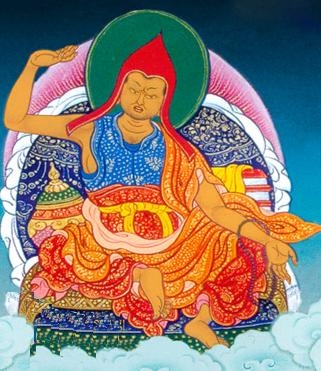Aryadeva: Difference between revisions
Jump to navigation
Jump to search
mNo edit summary |
mNo edit summary |
||
| Line 5: | Line 5: | ||
*''[[Four Hundred Verses]]'' | *''[[Four Hundred Verses]]'' | ||
*''Lamp that Integrates the Practices'' (Skt. ''Caryāmelāpaka-pradīpa''; Tib. སྤྱོད་པ་བསྡུས་པའི་སྒྲོན་མ་, [[Wyl.]] ''spyod pa bsdus pa'i sgron ma''), a treatise on the [[Guhyasamaja Tantra]]. | *''Lamp that Integrates the Practices'' (Skt. ''Caryāmelāpaka-pradīpa''; Tib. སྤྱོད་པ་བསྡུས་པའི་སྒྲོན་མ་, [[Wyl.]] ''spyod pa bsdus pa'i sgron ma''), a treatise on the [[Guhyasamaja Tantra]]. | ||
:{{ | :{{TBRCW|O00CR0008|O00CR000800CR031427$W23702|སྤྱོད་པ་བསྡུས་པའི་སྒྲོན་མ་, ''spyod pa bsdus pa'i sgron ma''}} | ||
*''Shatashastra'', which only remains in its Chinese translation by Kumārajīva. | *''Shatashastra'', which only remains in its Chinese translation by Kumārajīva. | ||
Revision as of 15:54, 24 December 2010

Aryadeva (Skt. Āryadeva; Tib. འཕགས་པ་ལྷ་, Pakpa Lha; Wyl. ‘phags pa lha) (second/third century) — one of the six great commentators (the ‘Six Ornaments’) on the Buddha's teachings. He was a disciple of Nagarjuna and devoted his life to continuing his master’s work, consolidating the Madhyamika tradition. He is also counted among the eighty-four mahasiddhas.
Writings
- Four Hundred Verses
- Lamp that Integrates the Practices (Skt. Caryāmelāpaka-pradīpa; Tib. སྤྱོད་པ་བསྡུས་པའི་སྒྲོན་མ་, Wyl. spyod pa bsdus pa'i sgron ma), a treatise on the Guhyasamaja Tantra.
- Shatashastra, which only remains in its Chinese translation by Kumārajīva.
Further Reading
- David Seyfort Ruegg, The Literature of the Madhyamaka School of Philosophy in India, Wiesbaden: Harrassowitz, 1981
- Lobsang N. Tsonawa, Indian Buddhist Pandits from The Jewel Garland of Buddhist History, Dharamsala: Library of Tibetan Works and Archives, 1985.
- Christian Wedemeyer, Vajrayāna & Its Doubles: A Critical Historiography, Exposition, and Translation of the Tantric Works of Āryadeva, PhD dissertation, Columbia University (New York 1999).